A) 2mg
B) P
C) f
D) mg
E) This cannot be determined from the information given.
Correct Answer

verified
Correct Answer
verified
Multiple Choice
A block is pulled at constant speed along a rough level surface by a rope that makes an angle of 30° with respect to the horizontal.The applied force along the rope is  .The force of kinetic friction between the block and the surface is 10 N.
.The force of kinetic friction between the block and the surface is 10 N. 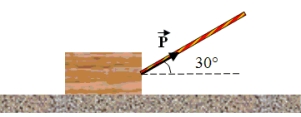 -Which one of the following expressions gives the magnitude of the force
-Which one of the following expressions gives the magnitude of the force  in SI units?
in SI units?
A) 10/(cos 30°)
B) 10/(sin 30°)
C) 10(cos 30°)
D) 10(sin 30°)
E) tan 30°
Correct Answer

verified
A
Correct Answer
verified
Multiple Choice
A book is resting on the surface of a table.Consider the following four forces that arise in this situation: (1) the force of the earth pulling on the book (3) the force of the book pushing on the table (2) the force of the table pushing on the book (4) the force of the book pulling on the earth -The book has an acceleration of 0 m/s2.Which pair of forces, excluding "action-reaction" pairs, must be equal in magnitude and opposite in direction?
A) 1 and 2
B) 1 and 3
C) 1 and 4
D) 2 and 3
E) 2 and 4
Correct Answer

verified
Correct Answer
verified
Multiple Choice
A 70.0-kg astronaut pushes to the left on a spacecraft with a force  in "gravity-free" space.The spacecraft has a total mass of 1.0 × 104 kg.During the push, the astronaut accelerates to the right with an acceleration of 0.36 m/s2.
in "gravity-free" space.The spacecraft has a total mass of 1.0 × 104 kg.During the push, the astronaut accelerates to the right with an acceleration of 0.36 m/s2. 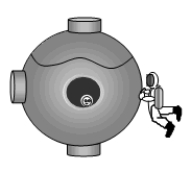 -Which one of the following statements concerning this situation is true?
-Which one of the following statements concerning this situation is true?
A) The spacecraft does not move, but the astronaut moves to the right with a constant speed.
B) The astronaut stops moving after he stops pushing on the spacecraft.
C) The force exerted on the astronaut is larger than the force exerted on the spacecraft.
D) The force exerted on the spacecraft is larger than the force exerted on the astronaut.
E) The velocity of the astronaut increases while he is pushing on the spacecraft.
Correct Answer

verified
Correct Answer
verified
Multiple Choice
Under what condition(s) will an object be in equilibrium?
A) If the object is either at rest or moving with constant velocity, it is in equilibrium.
B) If the object is either moving with constant velocity or with constant acceleration, it is in equilibrium.
C) Only if the object is at rest can it be in equilibrium.
D) Only if the object is moving with constant velocity can it be in equilibrium.
E) Only if the object is moving with constant acceleration can it be in equilibrium.
Correct Answer

verified
Correct Answer
verified
Multiple Choice
In which section of the graph is the magnitude of the net force decreasing?
A) I
B) II
C) III
D) IV
E) V
Correct Answer

verified
Correct Answer
verified
Multiple Choice
A block of mass M is hung by ropes as shown.The system is in equilibrium.The point O represents the knot, the junction of the three ropes.Which of the following statements is true concerning the magnitudes of the three forces in equilibrium? 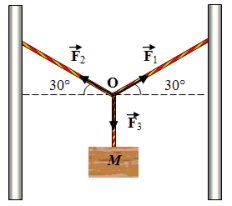
A) ![]()
B) ![]()
C) ![]()
D) ![]()
E) ![]()
Correct Answer

verified
A
Correct Answer
verified
Multiple Choice
Two forces act on a 16-kg object.The first force has a magnitude of 68 N and is directed 24° north of east.The second force is 32 N, 48° north of west.What is the acceleration of the object resulting from the application of these two forces to the object?
A) 1.6 m/s2, 5.5° north of east
B) 1.9 m/s2, 18° north of west
C) 2.4 m/s2, 34° north of east
D) 3.6 m/s2, 5.5° north of west
E) 4.1 m/s2, 52° north of east
Correct Answer

verified
Correct Answer
verified
Multiple Choice
Two 5-N boxes are attached to opposite ends of a spring scale and suspended from pulleys as shown.  -Suppose that the system were placed in an elevator that accelerates downward at 2 m/s2.What would the scale read?
-Suppose that the system were placed in an elevator that accelerates downward at 2 m/s2.What would the scale read?
A) 6 N
B) 8 N
C) 0 N
D) 4 N
E) 2 N
Correct Answer

verified
Correct Answer
verified
Multiple Choice
A 70.0-kg astronaut pushes to the left on a spacecraft with a force  in "gravity-free" space.The spacecraft has a total mass of 1.0 × 104 kg.During the push, the astronaut accelerates to the right with an acceleration of 0.36 m/s2.
in "gravity-free" space.The spacecraft has a total mass of 1.0 × 104 kg.During the push, the astronaut accelerates to the right with an acceleration of 0.36 m/s2.  -Determine the magnitude of the acceleration of the spacecraft.
-Determine the magnitude of the acceleration of the spacecraft.
A) 51.4 m/s2
B) 0.36 m/s2
C) 2.5 × 10-3 m/s2
D) 7.0 × 10-3 m/s2
E) 3.97 × 10-4 m/s2
Correct Answer

verified
Correct Answer
verified
Multiple Choice
Complete the following statement: The magnitude of the normal force could be reduced by
A) increasing the speed of the block.
B) decreasing the coefficient of kinetic friction.
C) decreasing the velocity of the block.
D) decreasing the angle made by the rope.
E) increasing the angle made by the rope.
Correct Answer

verified
Correct Answer
verified
Multiple Choice
A block is at rest on a rough inclined plane and is connected to an object with the same mass as shown.The rope may be considered massless; and the pulley may be considered frictionless.The coefficient of static friction between the block and the plane is µs; and the coefficient of kinetic friction is k. 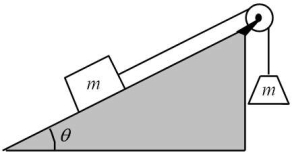 -If the mass of the suspended object is doubled, what will be the acceleration of the block up the plane?
-If the mass of the suspended object is doubled, what will be the acceleration of the block up the plane?
A) g(2 - k sin )
B) 2g( k sin - cos )
C) g(2tan - k sin )
D) g(2 - sin - k cos )
E) g(2cos - k sin )
Correct Answer

verified
Correct Answer
verified
Multiple Choice
A block of weight W is suspended by a string of fixed length.The ends of the string are held at various positions as shown in the figures below. In which case, if any, is the magnitude of the tension along the string the largest? 
A) case A
B) case B
C) case C
D) case D
E) The magnitude of the tension will be the same in all four cases, since the string must support the entire weight of the block.
Correct Answer

verified
A
Correct Answer
verified
Multiple Choice
A 10-kg block is pushed against a vertical wall by a horizontal force of 100 N as shown in the figure.The coefficient of static friction, s, between the block and the wall is 0.60; and the coefficient of kinetic friction, k, is 0.40.Which one of the following statements is true, if the block is initially at rest? 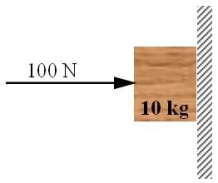
A) The total force exerted on the block by the wall is directed horizontally.
B) The block slides down the wall with an acceleration of magnitude 3.8 m/s2.
C) The block will slide down the wall because the force of static friction can be no larger than 60 N.
D) The block will remain at rest because the coefficient of static friction is greater than the coefficient of kinetic friction.
E) The block will slide down the wall because the coefficient of kinetic friction is less than the coefficient of static friction.
Correct Answer

verified
Correct Answer
verified
Multiple Choice
Two identical blocks are pulled along a rough surface as suggested in the figure.Which one of the following statements is false? 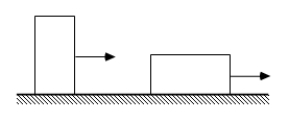
A) The coefficient of kinetic friction is the same in each case.
B) A force of the same magnitude is needed to keep each block moving.
C) A force of the same magnitude was required to start each block moving.
D) The normal force exerted on the blocks by the surface is the same for both blocks.
E) The magnitude of the force of kinetic friction is greater for the block on the right.
Correct Answer

verified
Correct Answer
verified
Multiple Choice
What is the weight of a 2.50-kg bag of sand on the surface of the earth?
A) 2.50 N
B) 9.80 N
C) 24.5 N
D) 49.0 N
E) 98.0 N
Correct Answer

verified
Correct Answer
verified
Multiple Choice
A spring scale is fastened to the ceiling of a railway car.When a 1.0-kg block is hung from the scale, it reads 12 N and is oriented as shown in the figure.  What is the approximate acceleration of the car as measured by an observer at rest on the ground outside of the car?
What is the approximate acceleration of the car as measured by an observer at rest on the ground outside of the car?
A) 7 m/s2 to the right
B) 7 m/s2 to the left
C) 12 m/s2 to the right
D) 12 m/s2 to the left
E) It is impossible to calculate since the angle has not been given.
Correct Answer

verified
Correct Answer
verified
Multiple Choice
A 975-kg car accelerates from rest to 26.7 m/s in a distance of 120 m.What is the magnitude of the average net force acting on the car?
A) 740 N
B) 2900 N
C) 91 N
D) 1300 N
E) 7900 N
Correct Answer

verified
Correct Answer
verified
Multiple Choice
A 250-N force is directed horizontally as shown to push a 29-kg box up an inclined plane at a constant speed.Determine the magnitude of the normal force, FN, and the coefficient of kinetic friction, µk.  FN µk
FN µk
A) 330 N 0.31
B) 310 N 0.33
C) 250 N 0.27
D) 290 N 0.30
E) 370 N 0.26
Correct Answer

verified
Correct Answer
verified
Multiple Choice
A 71-kg man stands on a bathroom scale in an elevator.What does the scale read if the elevator is ascending with an acceleration of 3.0 m/s2?
A) 140 N
B) 480 N
C) 690 N
D) 830 N
E) 910 N
Correct Answer

verified
Correct Answer
verified
Showing 1 - 20 of 103
Related Exams